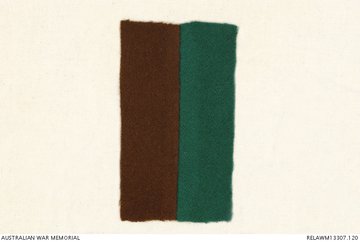
55th Battalion
The 55th Battalion was raised in Egypt on 12 February 1916 as part of the "doubling" of the AIF. Half of its recruits were Gallipoli veterans from the 3rd Battalion, and the other half, fresh reinforcements from Australia. Reflecting the composition of the 3rd, the 55th was predominantly composed of men from New South Wales. The battalion became part of the 14th Brigade of the 5th Australian Division.
Arriving in France on 30 June 1916, the battalion entered the frontline trenches for the first time on 12 July and fought its first major battle at Fromelles a week later. The battle was a disaster, resulting in heavy casualties across the division. Although in reserve, the 55th was quickly committed to the attack and eventually played a critical role, forming the rearguard for the 14th Brigade's withdrawal. Despite its grievous losses the 5th Division continued to man the front in the Fromelles sector for a further two months.
Source: Australian War Memorial
Fromelles
On the 16th July, the 55th were carrying supplies, readying for an attack the next day, but that was postponed due to the weather. Heavy bombardment was underway from both armies by 11.00 AM on the 19th July and by 4.00 PM all were in position for the battle. The main objective for the 14th Brigade was to take the trenches to the left of a heavily armed, elevated German defensive position, the ‘Sugar Loaf’, which dominated the front lines. If the Sugar Loaf could not be taken, the Australians would be subjected to murderous enfilade fire from the machine guns and counterattacks from that direction.
As they advanced, they were to link up with the 31st and 60th Battalions. The 55th’s role was to provide support for the attacking 53rd and 54th Battalions by digging trenches and providing carrying parties for supplies and ammunition. They would be called in as the ‘third battalion’ if needed for the fighting. As the battle began, C & D Companies’ carrying parties were in position 300 yards from the front line and Len’s B Company and A Company were ready to move after the first waves of the 53rd and 54th had gone forward. The 53rd and 54th went on the offensive from 5.43 PM. They did not immediately charge the German lines, but went out into No-Man’s-Land and laid down, waiting for the British bombardment to lift.
At 6.00 PM the German lines were rushed with 55th C & D Company’s working parties following in support. There was heavy artillery, machine gun and rifle fire, but they were able to advance rapidly.
The battle raged on. At about 3.00 AM some ‘foolish orders’ were circulated that they were being bombed by their own side and were supposed to retreat. These were believed to be incorrect and they continued to fight.
At 4.15 AM about 50 men of the 55th were ordered back to their own front line to defend against a rearguard action as the Germans were coming in from the exposed right flank:
“It was due to the very fine actions of these men that the garrison was able to get across No Man’s Land with comparatively few casualties.”
AWM4 23/14/4, 14th Brigade War Diaries July 1916 page 106
By 9.30 AM the Brigade had ‘retired with very heavy loss’.
Source AWM4 23/14/4 14th Brigade July 1916 page 7
The artillery finally ceased at noon. The Commanding Officer of the 55th, Lieutenant Colonel D. M. McConaghy spoke proudly of his men:
“The losses were heavy, but the battalion, four-fifths or more of whom were strangers to battle, acquitted themselves honorably in its first engagement, and returned with 40 German prisoners.”Australian War Memorial 55th Battalion War Diary 23/72/5 July 1916 page 5
For a battalion that was to be in reserve as the ‘third battalion’, the initial count at roll call was 42 killed or died of wounds, 154 wounded and 143 missing. Ultimately the impact was that 84 soldiers were killed or died from wounds, but of this total, 46 were missing/unidentified.
Source AWM C E W Bean, The AIF in France, Vol 3, Chapter XII, pg 369